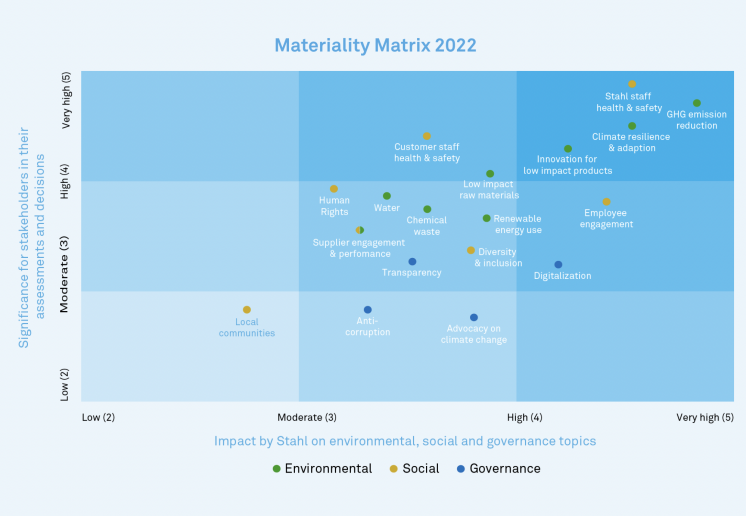

Back to overview

Scroll
down
Find out more about this report, including how we approached the materiality process and engaged stakeholders.
About Stahl’s ESG Report 2022
Our reporting period runs from January 1, 2022, to December 31, 2022, inclusive, and we have an annual reporting cycle with reports published in March, in accordance with the UN Global Compact deadline. The publication date of this report is March 20, 2022.
This report has been prepared, to the extent possible, in accordance with the GRI Standards: Core Option (download our 2022 GRI Content Index here). As indicated in the text and tables, our environmental, safety, and human resources data have been validated by a third-party verifier (Deloitte in 2022).
Stahl has published annual reports on environmental, social, and governance issues since 2013. The Global Reporting Initiative (GRI) sustainability reporting standards, the United Nations (UN) Global Compact, and the17 UN Sustainable Development Goals (SDGs) have been key references in the preparation of these reports and continue to provide valuable guidance.
Stakeholder engagement
More information about our stakeholders and how we engage with each of these different groups is available on the Stahl website here.
Stakeholder engagement is fundamental to our ESG strategy. We engage with a wide range of stakeholders, both internal and external to Stahl, to understand what our most material impacts are in relation to our stakeholders. Specifically, we look at the impact of Stahl’s activities on our different stakeholder groups in relation to our identified material topics and the steps we can take to improve our impact on our stakeholders, the environment and society. During these engagements, we also discuss how developments such as climate change will impact Stahl and our stakeholders in the coming years and what steps we can take to mitigate this. A list of key stakeholders and how we engage with them is available on our website.
A key focus for Stahl in recent years has been to increase our engagement with the wider chemical industry to promote positive change and foster knowledge-sharing in areas such as renewable feedstocks. This approach is reflected in our growing involvement with industry initiatives such as the Responsible Chemistry Initiative (RCI) and CLIB, as well as our strengthened focus on developing supply chain transparency.
Stahl conducts independent materiality-related interviews with its key stakeholders every two years, with the most recent materiality discussions taking place in 2021. This is part of our ongoing engagement with our primary stakeholders, which include our employees, customers, suppliers, investors, distributors, and agents, as well as our secondary stakeholders, which include academic institutions, governments (including public authorities), industry associations, foundations, consumer brands, NGOs, and civil society.
Our approach to materiality
Stahl’s approach to reporting and materiality is based on recognized, internationally agreed guidelines, such as the Global Reporting Initiative (GRI). This approach also ensures that the full scope of activities is considered, from operations to interactions with suppliers, customers, consumers, shareholders, governments, and NGOs.
In 2021, we updated our materiality analysis through desk research and interviews with key stakeholders such as suppliers, customers, and industry experts. The material topics we identified are presented in the matrix below. These topics impact the company, the environment, and our stakeholders, regardless of any mitigation measures that may take place.
In 2022, Stahl began the process of understanding the definition and methodology of a double materiality matrix, which is required for the forthcoming EU Corporate Sustainability Reporting Directive (CSRD).

Materiality Matrix 2022

Back
to top

Back to overview


Back
to top
Our approach to materiality
Stahl’s approach to reporting and materiality is based on recognized, internationally agreed guidelines, such as the Global Reporting Initiative (GRI). This approach also ensures that the full scope of activities is considered, from operations to interactions with suppliers, customers, consumers, shareholders, governments, and NGOs.
In 2021, we updated our materiality analysis through desk research and interviews with key stakeholders such as suppliers, customers, and industry experts. The material topics we identified are presented in the matrix below. These topics impact the company, the environment, and our stakeholders, regardless of any mitigation measures that may take place.
In 2022, Stahl began the process of understanding the definition and methodology of a double materiality matrix, which is required for the forthcoming EU Corporate Sustainability Reporting Directive (CSRD).
Stakeholder engagement
Stakeholder engagement is fundamental to our ESG strategy. We engage with a wide range of stakeholders, both internal and external to Stahl, to understand what our most material impacts are in relation to our stakeholders. Specifically, we look at the impact of Stahl’s activities on our different stakeholder groups in relation to our identified material topics and the steps we can take to improve our impact on our stakeholders, the environment and society. During these engagements, we also discuss how developments such as climate change will impact Stahl and our stakeholders in the coming years and what steps we can take to mitigate this. A list of key stakeholders and how we engage with them is available on our website.
A key focus for Stahl in recent years has been to increase our engagement with the wider chemical industry to promote positive change and foster knowledge-sharing in areas such as renewable feedstocks. This approach is reflected in our growing involvement with industry initiatives such as the Responsible Chemistry Initiative (RCI) and CLIB, as well as our strengthened focus on developing supply chain transparency.
Stahl conducts independent materiality-related interviews with its key stakeholders every two years, with the most recent materiality discussions taking place in 2021. This is part of our ongoing engagement with our primary stakeholders, which include our employees, customers, suppliers, investors, distributors, and agents, as well as our secondary stakeholders, which include academic institutions, governments (including public authorities), industry associations, foundations, consumer brands, NGOs, and civil society.
About Stahl’s ESG Report 2022
Our reporting period runs from January 1, 2022, to December 31, 2022, inclusive, and we have an annual reporting cycle with reports published in March, in accordance with the UN Global Compact deadline. The publication date of this report is March 20, 2022.
This report has been prepared, to the extent possible, in accordance with the GRI Standards: Core Option (download our 2022 GRI Content Index here). As indicated in the text and tables, our environmental, safety, and human resources data have been validated by a third-party verifier (Deloitte in 2022).
Stahl has published annual reports on environmental, social, and governance issues since 2013. The Global Reporting Initiative (GRI) sustainability reporting standards, the United Nations (UN) Global Compact, and the17 UN Sustainable Development Goals (SDGs) have been key references in the preparation of these reports and continue to provide valuable guidance.
Find out more about this report, including how we approached the materiality process and engaged stakeholders.

